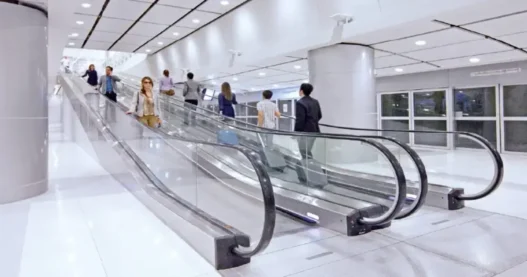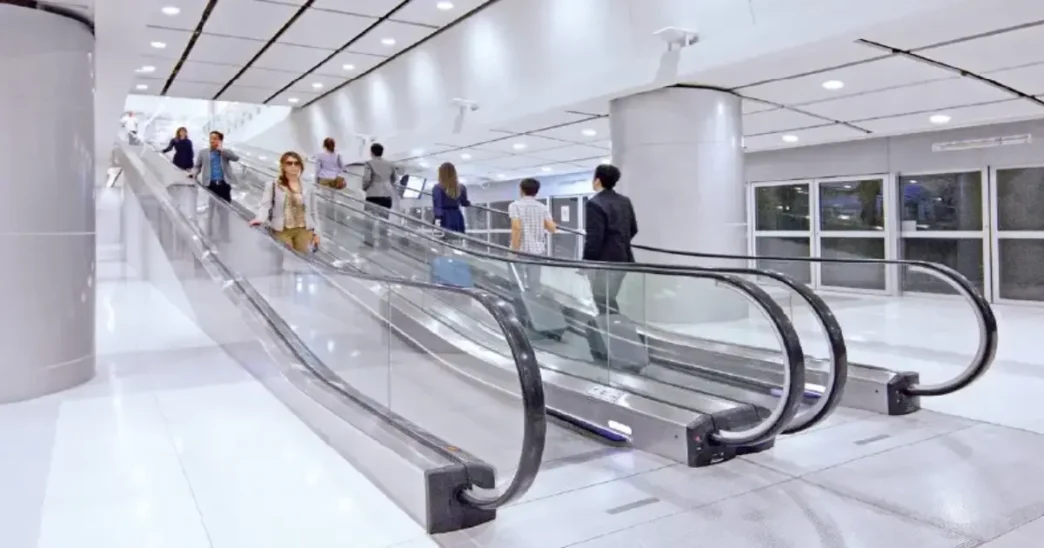If you’re in a rush, navigating large distances in crowded urban areas might be downright frustrating. A solution to this problem is moving walkways, which allow users to glide across large spaces with ease. When it comes to horizontal transportation in big venues like airports and retail malls, moving walkways—also called travelators—offer a revolutionary alternative to the more conventional elevators and escalators.
As said by Dubai elevator companies, moving walkways are essential for improving mobility in a fast-paced city like Dubai, where there is a constant demand for space efficiency and modern technology. Learn about the several kinds of moving walkways, how they function, and why they are so important to today’s infrastructure in this article.
A Moving Walkway: What Is It?
Transporting people across great distances with little effort is the basic idea behind moving walkways. These walkways are essentially continuous conveyor belts. Moving walkways are engineered to run horizontally or on a modest inclination, as opposed to escalators, which transport passengers vertically. Airports, shopping centers, exhibition centers, and other huge public areas where walking would take a long time are typical places to find them.
Typically, moving walkways are made of metal or rubber and function like escalators, only they don’t have stairs. Whether catching a flight or just strolling through a vast retail mall, users are whisked away to their destination in no time at all by merely standing on the belt. Mobile walkways provide an easy means to traverse long distances; its length can range from 100 to 300 feet, or even farther, depending on the environment.
Different Sorts of Moving Walkways
Moving walkways can be broadly categorized into two types: belt moving walks and pallet moving walkways.
1. Belt Moving Walkways
These are great for flat, lengthy expenses because of their smooth rubber surface. Airports and major malls often have them because they let people easily travel across large areas without having to walk the whole distance.
2. Pallet Moving Walkways
Identical to an escalator in design, these walkways differ from belts in that they are made of interlocking metal or plastic frames and have a more robust surface. These are commonly seen in very populated places, such as transit hubs and amusement parks, where they are needed for their lightweight and long-lasting design.
Although both kinds accomplish the same basic goal, their practical uses vary according to the setting and the requirements of the room.
Where Do You Typically Find Moving Walkways?
Although we usually see moving walkways at airports, you’ll be surprised to see that they’re popping up all around town. They facilitate the efficient movement of passengers between airport terminals and gates, reducing the strain and inconvenience of travel.
The use of moving walkways is not limited to airports, though; they are also common in major stadiums, convention centers, and retail malls. They make it easier for park goers to move from attraction to attraction without getting tired. Public transportation systems also make use of moving walkways; these facilitate faster foot traffic and easier passenger navigation in places like train stations and subway platforms.
What is the Significance of Moving Walkways?
Time Efficiency:
When you’re carrying a lot of bags, as in a mall or a stadium, it can be a real pain to walk the length of a large venue. By reducing the amount of effort needed to cross lengthy distances, moving walkways help you save time and energy. They also make it easier for the elderly and others with impairments to move around in big places without getting tired.
Optimizing Foot Traffic:
The purpose of moving walkways is to maintain a steady flow of foot traffic. They contribute to the alleviation of congestion and overcrowding in populated places by offering an efficient mode of transportation and reducing congestion. At airports, for example, they let people who are behind schedule get to their gate faster so that those who have more time to walk can do so without creating a backup.
Mobility:
People who have trouble walking, such as the elderly, those with disabilities, or those who are carrying large objects, find moving walkways to be an excellent accessibility feature. They facilitate their movement across great distances, making expansive areas more manageable for all users.
Moving Walkway Maintenance and Safety
Several characteristics guarantee the correct usage of moving walkways, which prioritize safety. The presence of handrails on most walks serves to mitigate the risk of falls, which is particularly advantageous for individuals lugging heavy bags. In the event of an emergency, users of more sophisticated systems can pause the pathway by pressing a button.
To keep everything running smoothly and safely, routine maintenance is a must. Due to the heavy use that moving walkways get, it is important to inspect and service them on a frequent basis to keep mechanical problems at bay and equipment life cycles extended.
How Moving Walkways Differ from Other Modes of Transportation
Moving walkways can transport more people simultaneously than elevators because they don’t need to stop at each floor. Moving walkways are great for horizontal travel over large distances, as opposed to elevators, which are usually utilized for vertical transportation. When it comes to vertical transportation, escalators are great, but they can only take you so far. Alternatively, moving walkways provide a seamless route that speeds up movement in expansive business areas.
In large buildings and complexes, an integrated system of transportation that includes moving walkways, escalators, and elevators allows for multi-directional mobility, improving efficiency and user experience.
How Moving Walkways Will Shape the Future
Moving walkways have limitless potential for development and integration into smart city frameworks. Soon, there may be walkways that change their speed depending on how many people are using them. Envision walkways that can detect when you’re in a rush and speed up appropriately, or that can sync with your phone to provide you with the best route. With so much room for improvement, mobile walkways will be essential in how people move about cities in the years to come.
Final Thoughts
With the advent of moving walkways, traversing enormous public areas is becoming second nature. They are an important component of contemporary infrastructure because of the time they save, the congestion they alleviate, and the accessibility they increase. To maintain efficient and seamless urban movement, moving walkways will become more crucial as cities expand and change.
Moving walkways are at the forefront of public transportation’s future, which will make commuting more convenient, efficient, and accessible for all.
An In-Depth Look at Moving Walkways: The Next Big Thing in Modern Transportation


An In-Depth Look at Moving Walkways: The Next Big Thing in Modern Transportation










